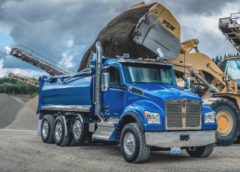Companies Now Have the Ability to Monitor Every Aspect of Their Fleets Remotely, Without Ever Stepping Foot on a Jobsite.
By John Rice
The world of aggregates has seen its fair share of innovative products hit the marketplace over the last 10 years. Through a mix of hardware and software solutions, companies now have the ability to monitor every aspect of their fleets remotely, without ever stepping foot on a jobsite.
While some organizations were quick to implement smart fleet technology, others have been selective, or slow to adopt solutions. Early adopters continue to gain valuable insights that enable them to improve cost certainty, identify and avoid potential problems, and find opportunities for efficiency improvements all through monitoring fleets and workflow remotely.
Since there are various features and tools available to monitor fleets remotely, it is important to have a clear understanding of what’s available and what solutions will improve productivity for dispatchers, drivers, maintenance and overall business operations. Here are some key features to look for in smart fleet technology solutions that will drive real business results.
Accurate Location and Status Updates
Timing is the key to success for any project. GPS technology is available on every smart device. The issue with construction sites is that often the address or site doesn’t actually exist yet.
Google maps will have a hard time locating a jobsite that isn’t registered. Any good GPS system built for aggregate vehicles should be able to get the driver to the site without having to plug in the nearest identifiable location. Not having the right GPS system could cause serious delays in delivery and a lot of unnecessary frustration between drivers and dispatchers.
There are also more than 20 different road types to travel, each with their own use classification and maximum weight limits. Aggregate drivers should be sent on a route that is capable of handling their vehicle. While fleets are being routed through capable roads and correct jobsite locations, status updates are being sent to site managers and fleet dispatchers, improving the entire product delivery process.
Reporting and Alerts
As with any other business, the aggregates industry is becoming a data-driven business. Smart fleet technology collects and stores information, providing mass quantities of data for reporting and analysis to help companies continue to manage their fleets more effectively and efficiently. Information on vehicle idle times, speed, acceleration and braking can all be recorded and analyzed to monitor fleet fuel efficiency.
The data collected should help answer questions, like:
- How much does equipment cost to maintain?
- Where is my business losing money?
- How much does one customer or account cost my business?
- What can my business do to be more productive?
- Which driver is performing the best?
Fleet maintenance was once an analog business. Companies would keep a manual log of when vehicles should be serviced, and if an unpredicted issue arises, it would cause a bump in the road for productivity. Now, smart fleet technology can be used to alert fleet managers when vehicle diagnostic issues arise, and will also alert managers to address preventative maintenance to ensure fleet safety and adhere to regulations.
Consistent Delivery Timing
Time is money. It takes a carefully orchestrated plan to keep construction projects on time. When one discipline misses a deadline, the whole project is held up. In this competitive environment, there is little room for timing mistakes.
Aggregate businesses must use savvy tools to meet client timelines and demands. Using smart fleet technology to monitor product delivery remotely and queue up additional vehicles will help eliminate some of the timing errors around product delivery.
Grows with Business
Who knew 20 years ago that we would be able to manage aggregate fleets remotely through innovative smart tools? With the rapid advances in innovation and evolving companies, hardware and software should have the ability to grow and adapt as business needs change.
Vendors should be investing in new tools and features that can easily integrate with core solutions. Ideally, smart fleet solution providers should identify a problem and provide a solution before their customer even knows they have a pain point.
Cross-Department Communication and Collaboration
The communication map within an aggregates company is complex. Smart fleet technologies allow for safe talk to text communication between drivers, dispatchers, site managers and other disciplines to ensure safety and delivery.
Sophisticated communication and collaboration technology enables fleet management to take place remotely without distracting drivers while operating a vehicle.
Some solutions allow drivers to communicate in user-defined talk groups or make point-to-point calls, enabling drivers to listen and talk to the necessary people without having to listen to excess radio chatter.
The ability to automatically save all messages in a database is another feature available on some platforms, which makes reporting information for audits both easier and more reliable.
Effective, smart, fleet-monitoring solutions should provide auto-status and tracking, dispatch integration, voice and text communication, and navigation as well as provide valuable data to improve productivity, safety and operating efficiencies.
Although there is an upfront investment in remote-monitoring technology, after implementation, aggregate companies should experience reduced delivery cycle times and increased efficiency, which provides a consistent service-level for customers.
With increased regulations, implementing smart fleet solutions will improve safety through better navigation displays and communication platforms, and more robust reporting for management to better informs and educates drivers on optimal safety practices.
At the end of the day, companies are measured by projects and profitability. There are many solutions on the market designed to help aggregate haulers make intelligent business decisions that can decrease operational costs and increase fleet efficiency for those who are willing to equip vehicle operators with the tools necessary to improve productivity.

John Rice is a vice president for Trimble Construction Logistics, which provides technology solutions designed specifically for the construction materials industry. He has more than 10 years of experience working with aggregate and ready mix companies to increase productivity through technology. He can be contacted at [email protected].

